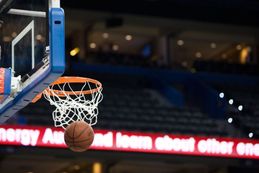
After reading Clay Barker’s post “Ranking basketball teams, using Generalized Regression,” I wondered how things had changed since the 2014-2015 NBA season.
Since the NBA season ended recently, I thought it was an appropriate time to revisit Clay’s analysis and see how the teams fared this season.
The Data
I downloaded the results of the 2016-2017 NBA season, including the playoffs, from basketball-reference.com. With these data, I used a Bradley-Terry model to find the strength of each team at home and on the road. From Clay’s post, the model and parameters here are:

The Results
I used the Generalized Regression platform in JMP Pro with Forward Selection to separate good (strength > 0), bad (strength < 0), and average (strength = 0) teams.
So what changed since 2015? Tables 1 and 2 show the top teams when playing at home and on the road in the 2014-2015 and 2016-2017 NBA seasons, respectively.
 Table 1. Top Teams in 2014-2015
Table 1. Top Teams in 2014-2015
 Table 2. Top Teams in 2016-2017
Table 2. Top Teams in 2016-2017
Three teams, Golden State, San Antonio, and Houston, remain in the top five for home strength. Atlanta and Portland have both taken a step back since 2015, while Washington and Cleveland improved.
In 2016-2017, only three teams stood out in terms of away strength, and they were also the top teams at home. It is also noteworthy that these three teams are all in the Western Conference, so no Eastern Conference team was considered strong when playing on the road in the 2016-2017 season.
One thing that remained the same since 2015 was Golden State’s dominance, both at home and on the road. For example, the model estimates their probability of beating San Antonio (the second best road team according to the model) at home is 91.5%.

Eastern Conference Champion Cleveland also had their hands full when Golden State came to town, with their win probability being 39.7%.

Now let’s take a look at the worst teams in the league. Tables 3 and 4 show the weakest teams when playing at home and on the road in the 2014-2015 and 2016-2017 NBA seasons.
 Table 3. Worst Teams in 2014-2015
Table 3. Worst Teams in 2014-2015
 Table 4. Worst Teams in 2016-2017Detroit, Philadelphia, Minnesota, and the Los Angeles Lakers were among the worst teams at home and on the road in both seasons. Dallas — the sixth best team on the road in 2015 — was among the worst road teams this season, although given their owner’s admission that the team intentionally lost games late in the season, this regression was not too surprising.
Table 4. Worst Teams in 2016-2017Detroit, Philadelphia, Minnesota, and the Los Angeles Lakers were among the worst teams at home and on the road in both seasons. Dallas — the sixth best team on the road in 2015 — was among the worst road teams this season, although given their owner’s admission that the team intentionally lost games late in the season, this regression was not too surprising.
Which teams were the biggest risers? Since two seasons passed since Clay’s analysis, it makes sense that many teams made dramatic improvements. Table 5 shows the teams with the biggest increases in home and away strength between the two seasons.
 Table 5. Best Strength Difference (2017 strength – 2015 strength)
Table 5. Best Strength Difference (2017 strength – 2015 strength)
For NBA fans, it should not be surprising to see some of the teams listed in the table above. Boston went from an average team to the top seed in the Eastern Conference. Minnesota improved thanks to the development of back-to-back No. 1 picks Andrew Wiggins and Karl-Anthony Towns. Golden State became even more dominant at home thanks to adding Kevin Durant in free agency.
I found it surprising that San Antonio was one of the most improved teams both at home and on the road. As one of the best franchises in the league, I was surprised they had much room for improvement. On the other hand, with all the negative headlines the Knicks received, it was surprising that New York improved as much as they did. They were still a bad team in 2017, with a strength rating of -0.79, but it was a large improvement over their rating of -1.354 in 2014-2015.
Unfortunately for fans of the teams in Table 6, there were also many teams whose performance declined over the course of two seasons.
 Table 6. Worst Strength Difference (2017 strength – 2015 strength)
Table 6. Worst Strength Difference (2017 strength – 2015 strength)
It was not shocking to see any of these teams identified by the models as teams that got worse since 2014-2015. Formerly strong teams including Memphis and Dallas have aged, while others such as Phoenix embraced a youth movement and let their younger players work their way through growing pains. Atlanta, a 60-win team in 2014-2015, had nearly an entirely different starting five in 2016-2017. Others such as Dallas tanked in 2016-2017 in hopes of earning a high lottery pick.
It was fun to look through the data and see how things had changed since the 2014-2015 NBA season. Hopefully, in the next few years the Charlotte Hornets will make a climb to the top of the rankings!
You must be a registered user to add a comment. If you've already registered, sign in. Otherwise, register and sign in.